From idyllic architecture of ancient Kyoto to the majestic sculptures of old-time Nara to the stunning paintings of Edo, Japan surely is a fabled chest of gold especially when it comes to distinguished arts and culture.
Each era of Japan’s history displayed distinct aesthetics inspired by a wide range of influences – from international exchange to religion to class structure. The social and political movements of each period are reflected in the country’s architecture, sculpture and paintings. The remaining artifacts can be explored and examined, each one sharing the unique story of Japan.
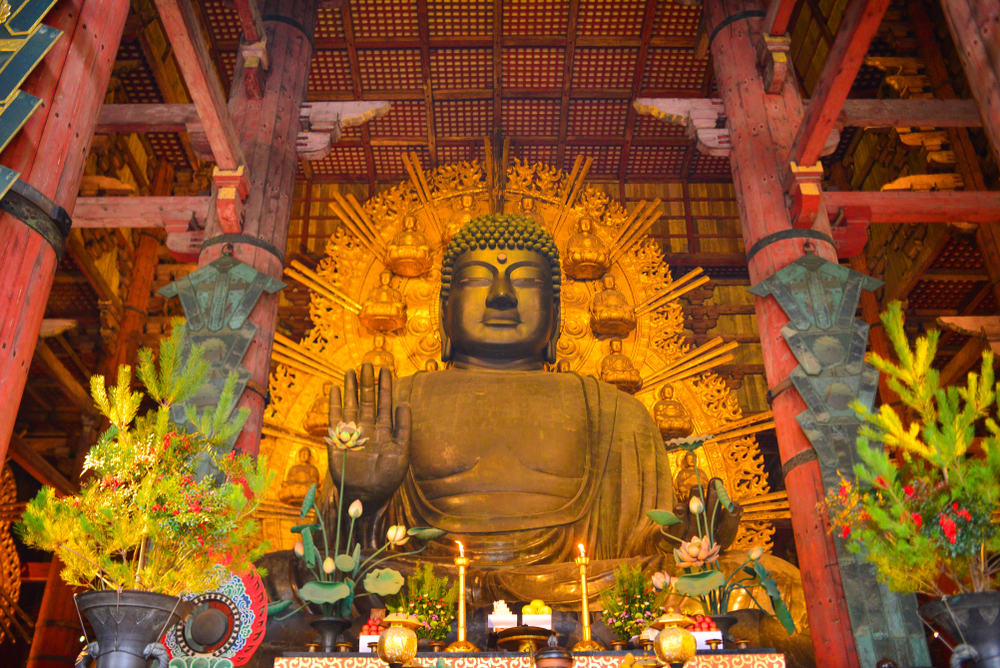
The Great Buddha at Todai-ji | Photo by khong katesorn / Shutterstock.com
The Early Influence of China and Korea
Prominent progress in Japanese art and culture was seen during the early Asuka Period (592-645), when Japan’s capital was located about 25km south of present-day Nara and architectural and sculptural techniques were imported from Kudara (one of the three kingdoms of Korea) along with Buddhism. The world heritage site, Horyu-ji in Ikaruga, is a superb complex of temples that encompasses the richness of Asuka culture. The Kudara Kannon statue enshrined within Horyu-ji displays a slender figure that exemplifies the typical features of statues found during the era.
By the latter half of the Asuka Period (645-710), the influence of the Tang Dynasty, considered the golden age of Chinese art and culture, filtered in, affecting the artists of Japan and leading to rounder images of Buddha. The plump and curvy features of the Yakushi Sanzon statues at Nara’s Yakushi-ji temple explicitly portray this exotic beauty found at the time.
The power of Buddhism elevated to its peak during the Nara Period (710-794). Emperor Shomu declared several national policies to promote the construction of temples and Buddha statues across a vast area. Todai-ji Daibutsuden in Nara, and the enshrined statue of the Great Buddha, are some astounding masterpieces of Buddhist art that are left as vestiges of the time.
In 794, to escape the swelling power of monks in Nara, the capital moved to Kyoto, which marks the dawn of the Heian Era (794-1192). The era lasted for almost four centuries and amidst its long rule, few unique streams of culture evolved to further build up the foundation of Japanese art.
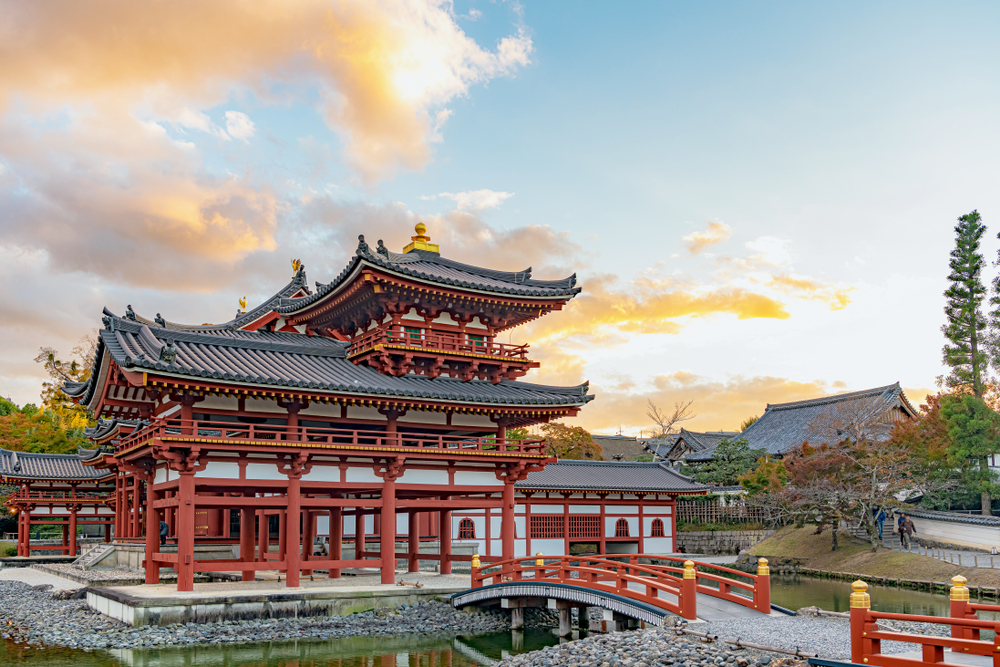
Byodoin temple
Kyoto’s Golden Age of Art & Culture
During early Heian period, new waves of Buddhism (Tendai, Shingon and Jodo) were introduced and altered the way in which people expressed their religious faith. A well-known example from the Shingon sect is the monk Kukai and his esoteric brand of Buddhism based at Mount Koya. The historic remains at Kongobu-ji temple are assets that clearly reflect the zeal of the Shingon faith.
Towards latter half of the Heian Period, the idea of kokufu bunka (Heian nationalism) flourished as Sugawara no Michizane broke off envoys to the Tang Dynasty in 894. The search for what constitutes the intrinsic beauty of Japan helped established a so-called Wafu culture. Some of the attributes of kokufu bunka includes the first manga, the scrolls of frolicking animals and yamato-e – a new painting genre that was used to illustrate The Tale of Genji.
At the same time, the teachings of Jodo Buddhism gained popularity amongst the aristocrats of Kyoto. The temples of Byodoin and Chuson-ji, which adopted a palatial architecture method known as shinden-zukuri, are some of the brilliant creations that reflect the lavish and elegant characteristics of the Heian aristocratic art. The stunning circuit style garden accompanied with many seasonal blooms and a big pond in the middle are remarkable works of natural art which depict the image of Jodo – pure land.
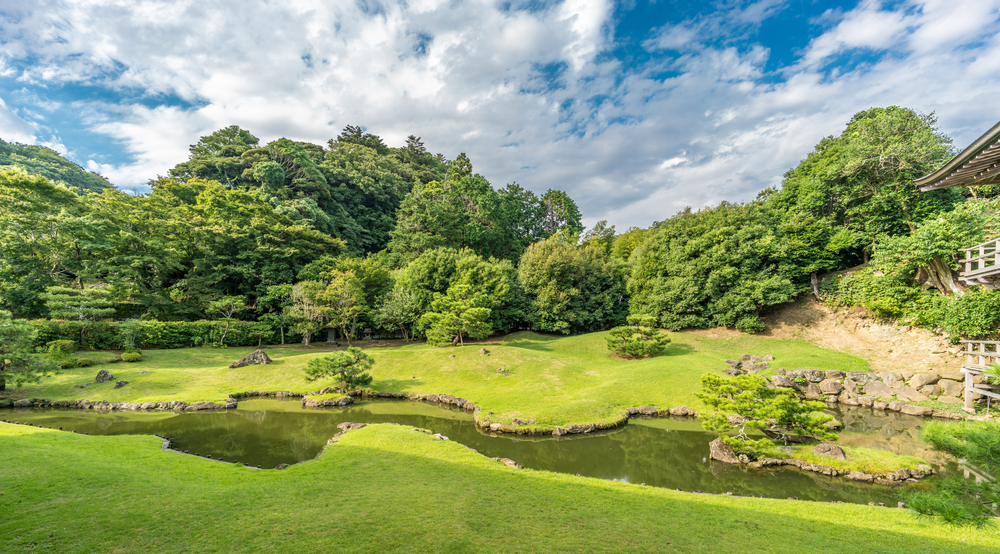
Kencho-ji garden
Kamakura Period Samurai Create Art in Their Own Image
By the 12th century, when Japan’s capital moved to Kamakura under the shogun Minamoto no Yoritomo, elements of warriors clearly came visible in artworks across the Kamakura period (1192-1336).
The magnificent structure of the Nandaimon Gate at Todai-ji temple in Nara, and the fierce and muscular figures of the Kongo Rikishi by sculptors Unkei and Kaikei, are excellent examples of samurai powers portrayed in Kamakura-era art.
Along with features of warriors, the ideology of mujyokan (impermanence) flourished amongst the samurais, which induced a brand new concept of aesthetics that focus on simplicity and subtly. The Zen temples and Zen gardens of Kencho-ji or Engaku-ji in Kamakura are some of the representative works that deserve a mention.
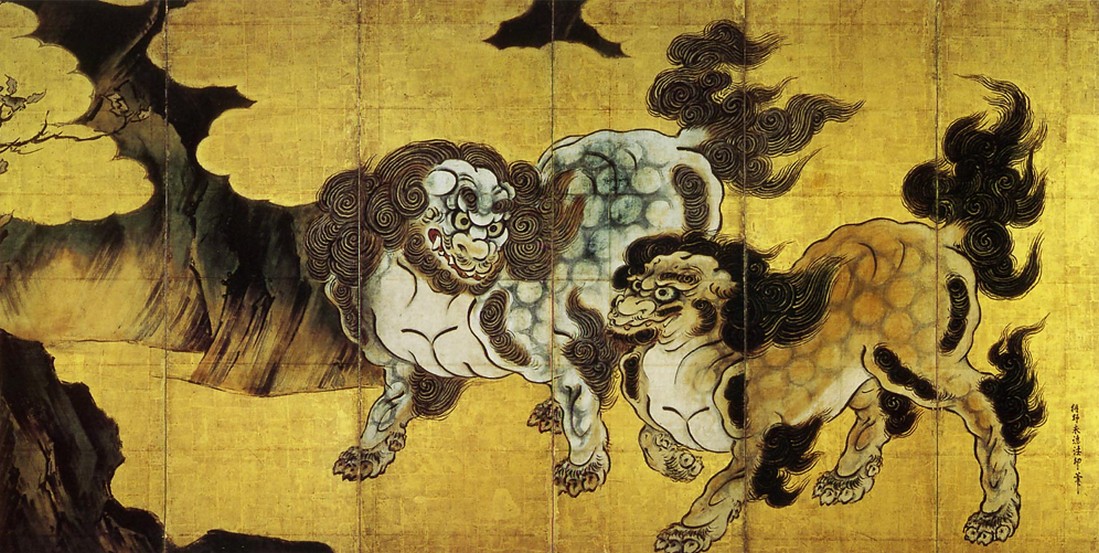
“Chinese Lions,” Kano Eitoku
Japan’s Warring States Period Leaves a Mark
Following the Kamakura Period, the Muromachi Shogunate initiated in Kyoto under the shogun Ashikaga Takauji. While the Muromachi Period (1336-1573) is predominantly characterized with anarchical wars between powerful daimyos, shoguns Ashikaga Yoshimitsu and Ashikaga Yoshimasa raised their artistic and cultural game amidst the frequent turmoil. The Togu-do building of Kyoto’s Silver Pavilion is a crucial breakthrough as its interior represents the origin of washitsu – the Japanese tatami room.
As the era moves to Azuchi-Momoyama period (1573-1603) the focus of art and culture shifts to human indulgence rather than considering it as a mere depiction of religion. The extravagant constructions of castle towers are great examples of architecture that exemplifies the human centric art and culture of the time.
Wall paintings classified as shohekiga – paintings on fusuma sliding doors and murals on indoor walls – also evolved as part of this trend and many splendid works were produced to brighten the shoguns’ dwellings, including Toyotomi Hideyoshi. The huge folding screen of the lion painted by Kano Eitoku and the folding screens of pines by Hasegawa Tohaku are leading examples of the era.
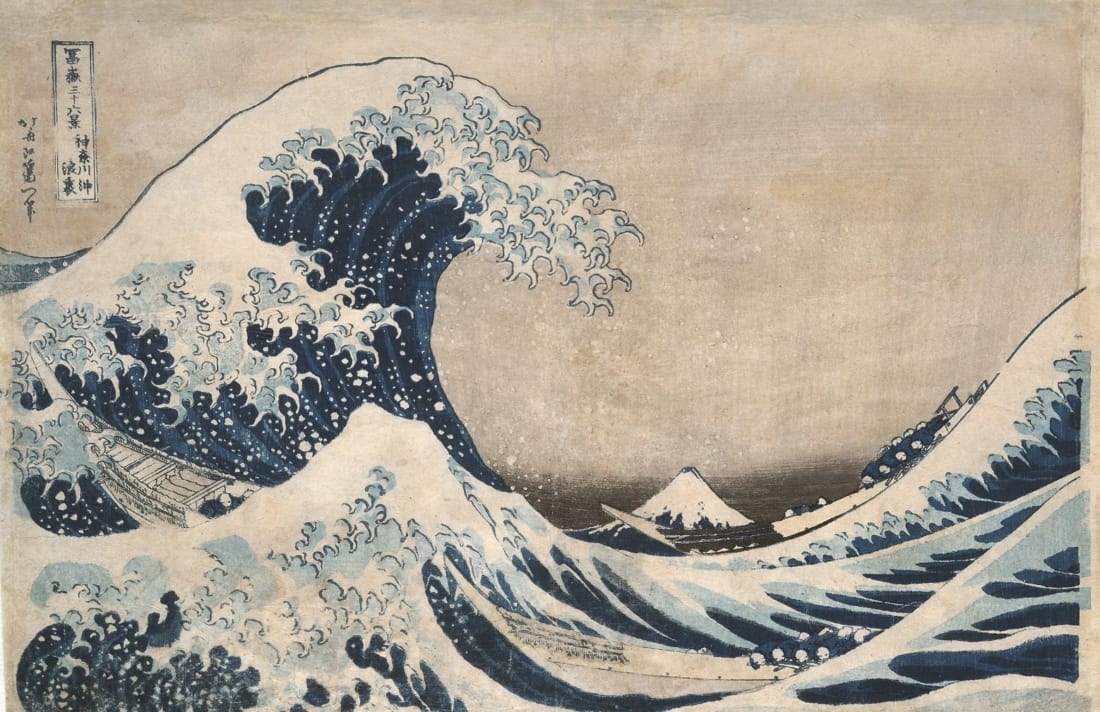
“The Great Wave Off Kanagawa,” Hokusai
Edo Period Brings Art to the Masses
Once the capital settled in Edo under the rule of Tokugawa Ieyasu in 1603, a more down to earth kind of art evolved across Japan during the Edo period (1603-1868).
For example, while the original washitsu of Togu-do was not meant for actual living, a new architectural technique called sukiya-zukuri offered proper space for people to reside in. Many of the rikyu (imperial villas) such as Katsura Rikyu and Shugakuin Rikyu in Kyoto are some of these examples.
Furthermore, towards the latter half of the Edo Period, the use of woodblock printing gained popularity and artworks became replicable for the rest of society to enjoy. Ukiyo-e is a perfect example of such replicable art that paid focus to the everyday life of local townsman. Series of ukiyo-e by Sharaku and Utamaro along with the famed paintings of Mount Fuji by Hokusai are great representations of the urbane concept of Edo-era art.
Even though the focus of art and culture gradually changed to suit the people of the middle class, the everlasting might of the shogun continued to prevail through the awe-inspiring Nikko Tosho-gu shrine in Nikko, which utilizes an architectural technique known as gongenzukuri – a style meant to integrate Buddhism with the native practices of Shintoism.
As stated by Beverly Sills, “Art is the signature of civilizations.” Whether it’s Buddhist art of the Asuka Period, Wafu culture of the Heian Period, samurai culture based on Zen or the urbane concept of Edo, each of these movements are signatures of civilization, and constitute a crucial foundation of Japanese art and culture.









